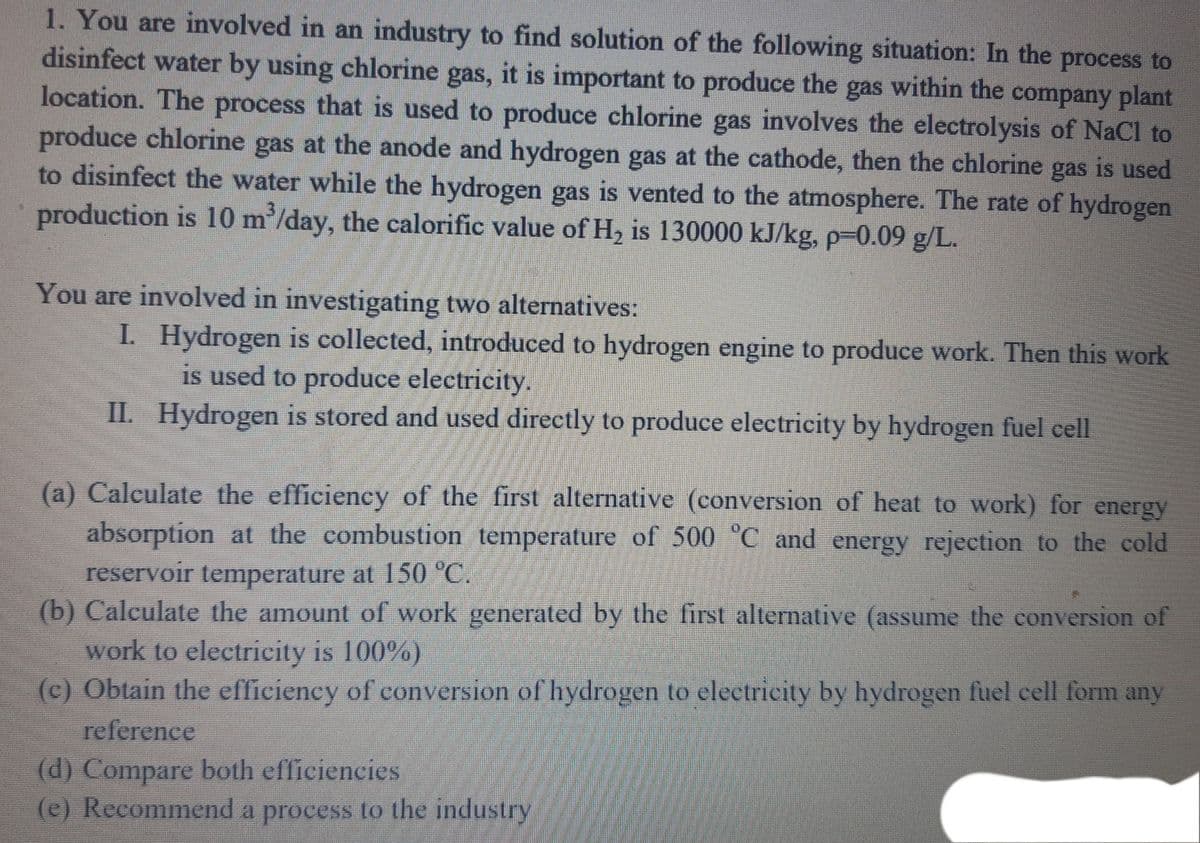1. You are involved in an industry to find solution of the following situation: In the process to disinfect water by using chlorine gas, it is important to produce the gas within the company plant location. The process that is used to produce chlorine gas involves the electrolysis of NaCl to produce chlorine gas at the anode and hydrogen gas at the cathode, then the chlorine to disinfect the water while the hydrogen gas is vented to the atmosphere. The rate of hydrogen production is 10 m/day, the calorific value of H, is 130000 kJ/kg, p-0.09 g/L. gas is used
1. You are involved in an industry to find solution of the following situation: In the process to disinfect water by using chlorine gas, it is important to produce the gas within the company plant location. The process that is used to produce chlorine gas involves the electrolysis of NaCl to produce chlorine gas at the anode and hydrogen gas at the cathode, then the chlorine to disinfect the water while the hydrogen gas is vented to the atmosphere. The rate of hydrogen production is 10 m/day, the calorific value of H, is 130000 kJ/kg, p-0.09 g/L. gas is used
Principles of Heat Transfer (Activate Learning with these NEW titles from Engineering!)
8th Edition
ISBN:9781305387102
Author:Kreith, Frank; Manglik, Raj M.
Publisher:Kreith, Frank; Manglik, Raj M.
Chapter5: Analysis Of Convection Heat Transfer
Section: Chapter Questions
Problem 5.39P
Related questions
Question

Transcribed Image Text:1. You are involved in an industry to find solution of the following situation: In the process to
disinfect water by using chlorine gas, it is important to produce the gas within the company plant
location. The process that is used to produce chlorine gas involves the electrolysis of NaCl to
produce chlorine gas at the anode and hydrogen gas at the cathode, then the chlorine gas is used
to disinfect the water while the hydrogen gas is vented to the atmosphere. The rate of hydrogen
production is 10 m'/day, the calorific value of H, is 130000 kJ/kg, p-0.09 g/L.
You are involved in investigating two alternatives:
I. Hydrogen is collected, introduced to hydrogen engine to produce work. Then this work
is used to produce electricity.
II. Hydrogen is stored and used directly to produce electricity by hydrogen fuel cell
(a) Calculate the efficiency of the first alternative (conversion of heat to work) for energy
absorption at the combustion temperature of 500 "C and energy rejection to the cold
reservoir temperature at 150 °C.
(b) Calculate the amount of work generated by the first alternative (assume the conversion of
work to electricity is 100%)
(c) Obtain the efficiency of conversion of hydrogen to electricity by hydrogen fuel cell form any
reference
(d) Compare both efficiencies
(e) Recommend a process to the industry
Expert Solution
This question has been solved!
Explore an expertly crafted, step-by-step solution for a thorough understanding of key concepts.
Step by step
Solved in 4 steps

Knowledge Booster
Learn more about
Need a deep-dive on the concept behind this application? Look no further. Learn more about this topic, mechanical-engineering and related others by exploring similar questions and additional content below.Recommended textbooks for you

Principles of Heat Transfer (Activate Learning wi…
Mechanical Engineering
ISBN:
9781305387102
Author:
Kreith, Frank; Manglik, Raj M.
Publisher:
Cengage Learning

Principles of Heat Transfer (Activate Learning wi…
Mechanical Engineering
ISBN:
9781305387102
Author:
Kreith, Frank; Manglik, Raj M.
Publisher:
Cengage Learning